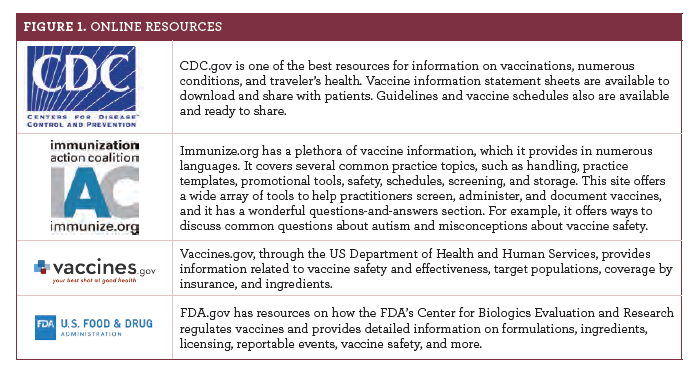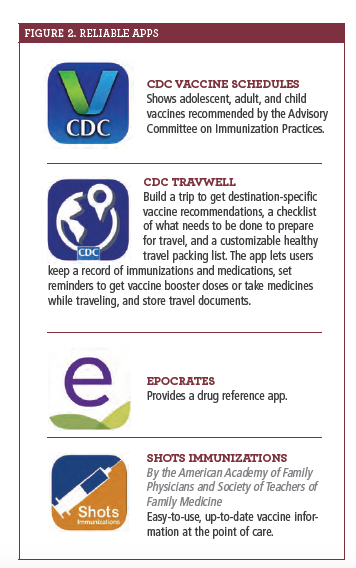
Share Vaccination Resources With Patients
These are websites and apps to assuage fears and provide appropriate education to reluctant individuals.
In primary care and retail health, vaccines are a cornerstone of preventive care and promoting wellness. They are backed by research, help prevent the spread of disease, and are safe and effective. Vaccines work so well that they are second only behind clean water in reducing the burden of infectious disease.1Vaccines eradicated smallpox,2saving millions of lives, and have dramatically reduced the incidences of 14 diseases: chicken pox, diphtheria, the flu, Haemophilus influenzae type b, hepatitis A, hepatitis B, measles, mumps, pertussis, pneumococcal disease, polio, rotavirus, rubella, and tetanus.3Between 1994 and 2013, vaccines prevented more than 21 million pediatric hospitalizations and 732,000 deaths.4
Although health care providers are aware of the many benefits of vaccinations and maintaining herd immunity, many patients are still wary of vaccinating their children or themselves. If patients need some convincing, consider the myriad benefits of vaccines1:
- Advancements for women.Child and infant mortality have decreased as vaccinations have become more prevalent, giving women the choice to have fewer children because those children are more likely to survive. This has led to economic, educational, health, and social benefits.
- Cancer prevention.Hepatitis B, which is preventable with vaccination, can cause liver cancer, and human papillomavirus vaccines protect against serotypes 16 and 18, which account for more than 70% of cervical cancers.
- Combating antibiotic resistance.When fewer people get sick, fewer need antibiotics, which means less antibiotic resistance. For example, in 2000, when the conjugate pneumococcal vaccine was introduced for infants, the United States “saw a 57% decline in invasive disease caused by penicillin-resistant strains and a 59% decline in strains resistant to multiple antibiotics by 2004 across a broad age spectrum.”
- Economic benefits.A healthy population is associated with economic and social growth. Research has found that the annual return on investment is about 12% to 18%.
- Health care and other savings for society. Vaccinations are estimated to lead to billions of dollars in savings annually.
- Herd immunity.One important factor that many people do not understand is how their vaccinations can affect the health and safety of others. Maintaining high vaccination rates protects unvaccinated individuals and provides a level of protection for the most vulnerable patients, such as elderly individuals, infants, patients with cancer, or anyone who has a true medical contraindication to vaccinations.
- Improved travel safety.The availability of travel vaccines, such as cholera, hepatitis B, Japanese encephalitis, rabies, typhoid, and yellow fever, decreases the chances of contracting endemic diseases and spreading them.
- Increased life expectancy.Elderly patients are particularly susceptible to the dangers of the flu. Getting a flu shot can reduce their chances of having cardiovascular or cerebrovascular disease.1
- Protection against other conditions.The flu vaccine has been shown to reduce the number of acute otitis media infections in children, and the measles vaccine has been shown to protect against sequelae, such as bacterial pneumonia, dysentery, keratomalacia, and malnutrition.

Despite the fact that vaccines are subjected to rigorous testing to ensure their safety, many patients still have concerns. One way to assuage their fears is by providing them with sufficient education. figures 1 and 2 show excellent vaccination resources.
Before administering vaccines to patients, make sure that they are appropriate candidates for the vaccine, have been properly informed, and have no contraindications. The CDC provides a vaccine information statement (VIS), and this should be given to patients prior to injection. These statements cover contraindications, how the vaccines work, risks, what do to in case of an adverse reaction, and why patients should get vaccinated.

Sara Hunt, MSN, RN, PHN, FNP-C,is a licensed and board-certified family nurse practitioner, a public health nurse, an adjunct assistant professor of health policy, and a doctor of nursing practice student at the University of California, San Francisco. She was the spring 2015 health policy fellow at the American Association of Nurse Practitioners’ Government Affairs Office in Washington, DC.
REFERENCES
- Andre FE, Booy R, Bock HL, et al. Vaccination greatly reduces disease, disability, death and inequity worldwide. Bull World Health Organ. 2007;86(2):140-146
- Smallpox. National Institute of Allergy and Infectious Diseases website. www.niaid.nih.gov/diseases-conditions/smallpox. Updated December 11, 2014. Accessed February 26, 2019.
- 14 diseases you almost forgot about (thanks to vaccines). CDC website. cdc.gov/ vaccines/parents/diseases/child/14-diseases.html. Updated May 30, 2018. Accessed February 28, 2019.
- Report shows 20-year US immunization program spares millions of children from diseases [press release]. Atlanta, GA: CDC; April 24, 2014. cdc.gov/media/releases/2014/p0424-immunization-program.html. Accessed February 28, 2019.
Knock Out Aches and Pains From Cold
October 30th 2019The symptoms associated with colds, most commonly congestion, coughing, sneezing, and sore throats, are the body's response when a virus exerts its effects on the immune system. Cold symptoms peak at about 1 to 2 days and last 7 to 10 days but can last up to 3 weeks.
COPD: Should a Clinician Treat or Refer?
October 27th 2019The Global Initiative for Chronic Obstructive Lung Disease (GOLD) defines the condition as follows: “COPD is a common, preventable, and treatable disease that is characterized by persistent respiratory symptoms and airflow limitation that is due to airway and/or alveolar abnormalities usually caused by significant exposure to noxious particles or gases.â€
Diabetic Ketoacidosis Is Preventable With Proper Treatment
October 24th 2019Cancer, diabetes, and heart disease account for a large portion of the $3.3 trillion annual US health care expenditures. In fact, 90% of these expenditures are due to chronic conditions. About 23 million people in the United States have diabetes, 7 million have undiagnosed diabetes, and 83 million have prediabetes.
What Are the Latest Influenza Vaccine Recommendations?
October 21st 2019Clinicians should recommend routine yearly influenza vaccinations for everyone 6 months or older who has no contraindications for the 2019-2020 influenza season starting at the end of October, according to the Advisory Committee on Immunization Practices.
What Is the Best Way to Treat Pharyngitis?
October 18th 2019There are many different causes of throat discomfort, but patients commonly associate a sore throat with an infection and may think that they need antibiotics. This unfortunately leads to unnecessary antibiotic prescribing when clinicians do not apply evidence-based practice.
Knock Out Aches and Pains From Cold
October 30th 2019The symptoms associated with colds, most commonly congestion, coughing, sneezing, and sore throats, are the body's response when a virus exerts its effects on the immune system. Cold symptoms peak at about 1 to 2 days and last 7 to 10 days but can last up to 3 weeks.
COPD: Should a Clinician Treat or Refer?
October 27th 2019The Global Initiative for Chronic Obstructive Lung Disease (GOLD) defines the condition as follows: “COPD is a common, preventable, and treatable disease that is characterized by persistent respiratory symptoms and airflow limitation that is due to airway and/or alveolar abnormalities usually caused by significant exposure to noxious particles or gases.â€
Diabetic Ketoacidosis Is Preventable With Proper Treatment
October 24th 2019Cancer, diabetes, and heart disease account for a large portion of the $3.3 trillion annual US health care expenditures. In fact, 90% of these expenditures are due to chronic conditions. About 23 million people in the United States have diabetes, 7 million have undiagnosed diabetes, and 83 million have prediabetes.
What Are the Latest Influenza Vaccine Recommendations?
October 21st 2019Clinicians should recommend routine yearly influenza vaccinations for everyone 6 months or older who has no contraindications for the 2019-2020 influenza season starting at the end of October, according to the Advisory Committee on Immunization Practices.
What Is the Best Way to Treat Pharyngitis?
October 18th 2019There are many different causes of throat discomfort, but patients commonly associate a sore throat with an infection and may think that they need antibiotics. This unfortunately leads to unnecessary antibiotic prescribing when clinicians do not apply evidence-based practice.
2 Commerce Drive
Cranbury, NJ 08512
All rights reserved.
